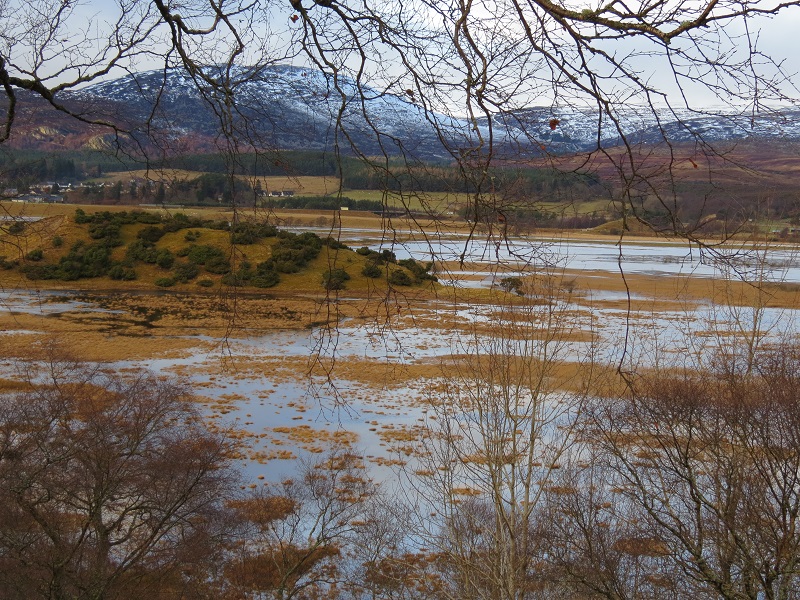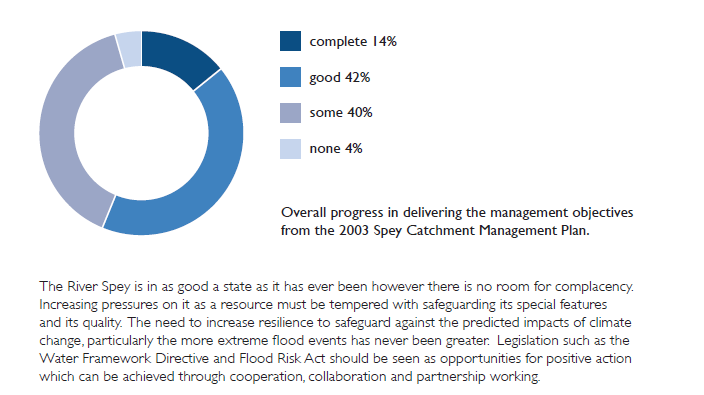
The new River Spey catchment management plan was published in November (see here) and announced by the Cairngorms National Park Authority in December. The first plan was in 2003 (see here), the year the CNPA was created, and a review of progress conducted in 2015 was published earlier in 2016 (see here). Its yet another plan which should affect what happens in our National Park (half the Spey catchment is within the CNPA boundary), but does it? Conversely, has the National Park made a difference to what’s in the plan?
While the introduction to the new Plan claims that “that considerable progress has been made in many areas” since 2003, the Review report indicates otherwise: 
The Review Report, besides indicating that progress over the last 12 years has been slow, shows a striking division between where progress has been good and where it has been more limited. The Review reports significant progress on preventing pollution of the Spey and its tributaries (eg discharges from distilleries, run off of agricultural chemicals) and flood warning systems, both of which are the responsibility of the Scottish Environment Protection Agency. By contrast it shows relatively little progress on issues of sustainable land management and conservation of species associated with river habitats (where the CNPA arguably has lead responsibility). Indeed, the conservation related actions where best progress appears to have been made relate to species protected under European legislation (e.g lamprey), where SNH has been targetting its efforts, rather than landscape scale conservation (which is what the CNPA has identified as one of the 9 Big Issues facing the National Park).
While it would be easy to read too much into indicators of progress, which can contain many subjective judgements, there is nothing in the Review Report that indicates the National Park has made much of a difference so far. It would need further research comparing progress on the Spey with rivers outwith National Park boundaries to establish this more objectively but I think this should be of concern to both the CNPA and the public.
Unfortunately, I am not sure the new plan will make any difference. This is partly because of it has no teeth. The introduction states this clearly: the plan, which “has been developed by the Spey Catchment Initiative Steering Group (SCISG) in no way overrides, takes precedence over, or prioritises any organisation’s or individual’s remit.” In other words it does not bind any of the partners to do anything. Its also due to the belief (contained in the quote from the Review above), that everything can be achieved by “co-operation, collaboration and partnership working”. Unfortunately, what this has led to is a lowest common denominator approach where the plan only contains objectives that the various partners can agree on, rather than what should happen in a National Park. There are several good illustrations of this.
Moorland and river catchment planning
The first is that there are just two mentions of moorland in the entire Plan despite moorland covering half the catchment area. The Plan contains quite a bit on the impact of farming, both on water quality (agricultural pollution) and flooding (flood plains provide most of best agricultural land) but nothing on moorland. This contrasts with the original 2003 Plan which at least contained a section on moorland which explains (part of) its importance to river catchment planning:
So, why does the 2016 Plan say NOTHING explicitly about what needs to done on moorland? A possible explanation is that estates have refused to co-operate and, since the whole Plan depends on co-operation, moorland has been simply left out. Meantime the role of moorland in promoting flooding downstream has become much better known and was even referred to in the draft CNPA Partnership Plan, though no concrete actions were proposed there. Its now well established that both muirburn and bulldozed hill tracks promote water run-off, the opposite of what is required, but in the Plan there is not even a suggestion these issues need to be tackled though there is one vague action point “Manage land, particularly in the uplands, in a way that attenuates rates of runoff (thereby reducing the severity of floods and droughts)”. This is not just a missed opportunity, its scandalous. The Plan though does contain a section of community planting of trees to try and reduce the impacts of flooding downstream. This is misguided effort. The main focus to reduce the flow of water run-off from the hills needs to be upstream and therefore either involve landowners, or, should they not co-operate, involve compulsory measures that change how the land is managed.
The Catchment Plan and the draft CNPA Partnership Plan
The second, and related issue, is that the Catchment Plan makes no reference to the draft CNPA Partnership Plan although this was published early summer 2016. This is strange because one of the Big 9 issues the CNPA identified in that Plan was flood management and one of the proposed actions in that paper to reduce flooding was “Reduced speed of water run-off from uplands” – which would imply changes to moorland management. Ironically the draft Partnership Plan identifies Catchment Plans – such as the new one for the Spey – as one of the key delivery mechanisms for any actions agreed in the new Partnership Plan actions and claims “Catchment Initiatives have been very successful as a delivery mechanism, engaging with stakeholders and communities.” So how is the Catchment Plan going to deliver the objectives of the Partnership Plan when there is no join up between the two plans?
I am coming to the conclusion that the multiplicity of plans in the National Park has simply become a mechanism to ensure no-one in the National Park actually takes responsibility for what happens.
Beavers
The Catchment Plan was finalised about the same time as Roseanna Cunningham announced she had approved the re-introduction of beavers to Scotland, so I was interested to see what it had to say about beavers:
Support and manage beaver reintroduction or colonisation should it occur.
Should beavers be reintroduced to the Spey, monitor numbers and their impacts on farmland and woodland
Absolutely nothing about the positive role beavers could play in flood prevention or tourism or the fact the Speyside has previously been identified by research undertaken by the National Park (see here) as one of the places most suitable for their re-introduction. No vision! Just sit back and see if the re-introduction of beavers occurs. Now, I am pretty certain this is not what front-line staff working on nature conservation and flood prevention in the National Park would want, and I think the explanation is that staff have been told “don’t put anything about beavers in the plan” because it could upset the farming lobby. What does this say about the conservation objectives of the National Park?
If this was a proper partnership plan, rather than a lowest common denominator one, it would be proposing dates for beaver re-introduction and ways that farmers could be compensated for any losses.
River catchment management and outdoor recreation
While the Plan touches on outdoor recreation, there is no explicit reference to the struggle that is going on at present between riparian landowners and outdoor recreation interests, whether this is landowners keeping walkers from the Spey (see here) or blocking off launching points for kayaks downstream of the National Park. Reading the plan you would simply not know there were major outdoor recreation issues or about the failures of the current mechanism of the Spey Users Group to resolve conflicts.
River catchment and hydro schemes
The Catchment Plan mentions how the older hydro schemes (e.g the Spey dam) have affected water flow and fish movements while also explicitly encouraging community hydro schemes, such as that at Kingussie. It does this without any discussion about where hydro schemes might be appropriate and where not. Since small hydro schemes are the developments most likely to have an impact on how water flows through the Spey catchment, this omission is surprising.
Its also surprising though because the CNPA has produced guidance on landscape sensitivity and this includes a section on small hydro schemes http://cairngorms.co.uk/park-authority/planning/landscape-sensitivity/?small-hydro. This is an area where the CNPA is far in advance of the Loch Lomond and Trossachs National Park which does not give any geographical indications or where hydro is more likely to be acceptable. Yet having indicated for the whole of the Spey catchment areas where hydro might be more or less acceptable, there is no mention of this in the Spey Catchment Plan. Another failure to join up different plans and policies.
What needs to happen?
The Spey Catchment Plan has too many serious omissions for the CNPA to be able to use it as a delivery mechanism for the new Park Partnership Plan. Either the Catchment Plan needs to be re-written and quickily, which I cannot see happening, or the CNPA in putting forward its Partnership Plan for Ministers needs to include clear plans and actions for the following, based on what I have outlined above:
- a clear plan for moorland restoration which will reduce the rate of water run-off from the hills (this could include both peatland restoration and reforestation)
- a clear statement of the role of hill tracks in promoting water run off and a commitment to remove unlawful tracks and restore the ground
- a commitment to re-introduce beavers to the Spey catchment within the next two years
- a clear statement that the interests of riparian owners will no longer be treated as taking precedence over recreational interests and a commitment to resolve conflicts between the two
- a clear statement of where hydro schemes would not be appropriate, either on grounds of landscape sensitivity or ecology or outdoor recreation